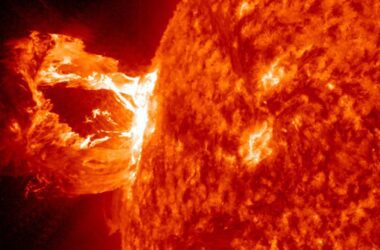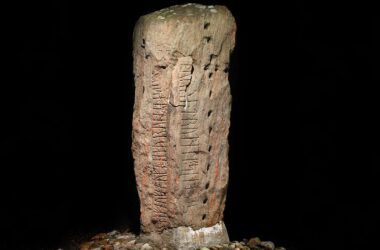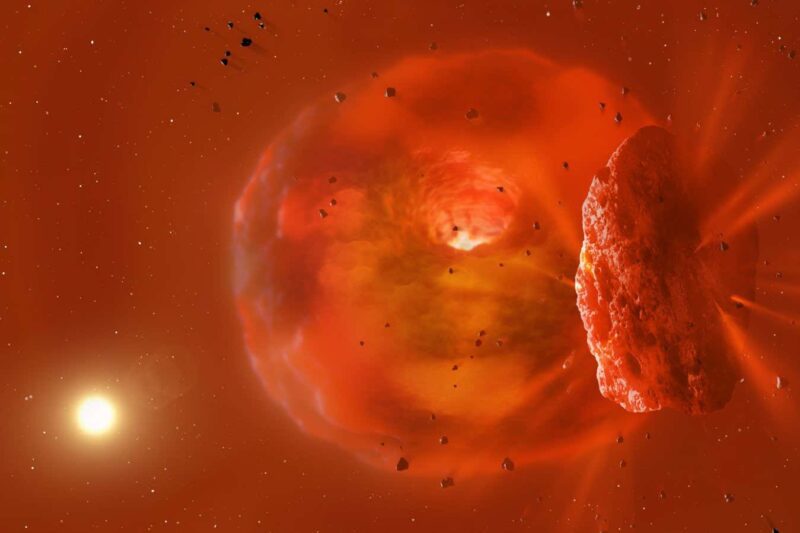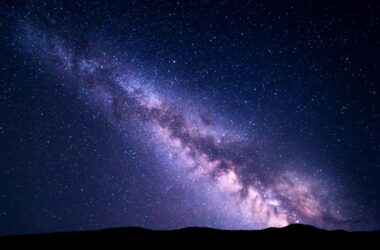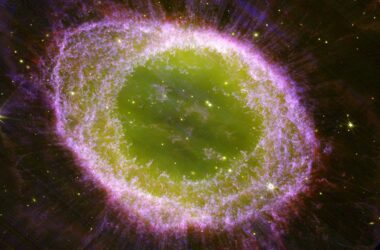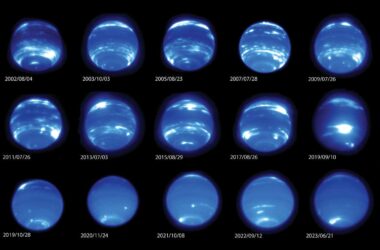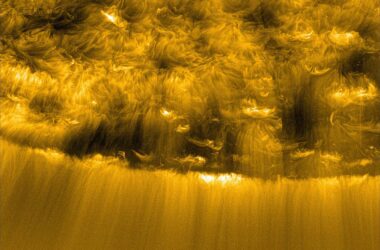An illustration of the huge, glowing doughnut produced by planets colliding
Mark Garlick
Two enormous planets may have collided and been destroyed, leaving a burning, hot doughnut, in a star system 1800 light years away from our own. This is the first time humans have witnessed both the impact and the aftermath of a planetary collision in real time.
A sun-like star, designated ASASSN-21qj, was observed by astronomers to have faded by as much as 95% in 2021. Past measurements of the star by Matthew Kenworthy and colleagues at Leiden University in the Netherlands revealed that three years prior to the dimming, the star had doubled in brightness.
They believe that an explosive collision between two huge planets is to blame for the star’s sudden brilliance and subsequent dimming, with a doughnut-shaped disc of hot dust and gas orbiting the star in the place of the planets and obscuring our view of the light years later.
“We went through a whole series of possible ideas,” Kenworthy explains. The facts we have suggest that the most likely scenario involves a collision between two ice giants. This is the very first instance of its kind.
Both planets would have been comparable in mass to Neptune and would have orbited their star at a distance close to Jupiter’s orbit around the sun. A “giant ball of silica vapour” nearly seven times the size of our sun would have been left behind after they collided, according to Kenworthy.
If an observer were present at the time of the impact, they would have seen a “bright red glowing collision,” with rock and debris being blasted out from the solid cores of the planets, as described by Kenworthy.
At its core, a remnant would have burnt white-hot, creating a torus-shaped ring around the star that would reach temperatures of about 700 degrees Celsius. The researchers concluded that the two planets were ice giants like Neptune and Uranus because their temperatures were around half of what would have been predicted if the planets were rocky. In a few thousand years, the remnants could coalesce into a new planet with its own solar system and many moons.
It’s unknown what caused the planets’ collision. It’s possible that a passing star or planet messed with their orbits, leading to a collision that released as much energy in a single instant as a small star burning for two years.
According to Jonathan Marshall of Taiwan’s Academia Sinica Institute of Astronomy and Astrophysics, “we have good evidence that planetary collisions do occur,” as the Moon is thought to have been formed when a Mars-sized object called Theia smashed into Earth. However, Marshall has previously suggested that the darkening of ASASSN-21qj was not caused by a planetary impact but rather by comets breaking apart in the system. We didn’t think there was enough weight to warrant anything more than small bodies getting engaged,” adds Marshall.
As André Izidoro of Rice University in Houston, Texas, points out, “super-Earths and mini-Neptunes are super common close to other stars, so giant impacts among them should also be super common,” the possibility of a giant impact in this system is “not out of the question.”
However, as a star system ages, the frequency with which such occurrences occur should decrease. Kenworthy and his coworkers estimate that ASASSN-21qj is 300 million years old, whereas previous estimates put the age of the solar system’s most chaotic phase at roughly 100 million years after the sun’s formation. If Izidoro is right, it proves that large impacts can occur much later in Earth’s history.
The James Webb Space Telescope, among others, could help us learn whether or not the planetary collision theory is right through additional observations of the system. From the dust cloud, Kenworthy predicts that further light from the system will become visible during the next five to ten years. “If it doesn’t do that, then something else is going on.”
FAQs
- Where did the potential planetary collision occur?
- The collision is believed to have occurred in the star system ASASSN-21qj, located 1800 light years away from our own.
- What evidence suggests a collision between two planets in the ASASSN-21qj system?
- The star ASASSN-21qj was observed to have faded by up to 95% in 2021, and three years prior, it had doubled in brightness. This sudden brilliance and subsequent dimming are attributed to a collision between two massive planets.
- What aftermath did the collision leave behind?
- The collision is believed to have left behind a doughnut-shaped disc of hot dust and gas orbiting the star, obscuring our view of the light.
- How do the planets involved in the collision compare to planets in our solar system?
- Both planets involved in the collision would have been similar in mass to Neptune and would have orbited their star at a distance akin to Jupiter’s orbit around the sun.
- What could future observations with the James Webb Space Telescope reveal about this event?
- The James Webb Space Telescope could provide more insights into whether the planetary collision theory is correct by observing the system further. If more light becomes visible from the dust cloud in the next five to ten years, it could support the collision theory.
